Analysis of Employee Motivation and Retention at Halkin Hotel
VerifiedAdded on 2020/02/14
|15
|3483
|210
Report
AI Summary
This report delves into the critical issue of employee motivation within the Halkin Hotel, a luxury establishment in London. The study identifies high employee turnover as a primary concern, attributing it to a lack of motivation stemming from factors such as low wages, long working hours, inadequate recognition, and insufficient training programs. The report analyzes the causes of this demotivation, exploring the negative implications on both the workers and the organization, including reduced productivity, decreased customer satisfaction, and damage to the hotel's reputation. Drawing upon motivational theories like Maslow's hierarchy, Alderfer's ERG theory, Herzberg's two-factor theory, and Attribution theory, the report provides a comprehensive analysis of the underlying issues. The report emphasizes the need for the management to review HR policies and motivation programs to ensure employee satisfaction. The report concludes by highlighting the need for the Halkin Hotel to implement motivating factors within the company, improve communication, and improve employee engagement.
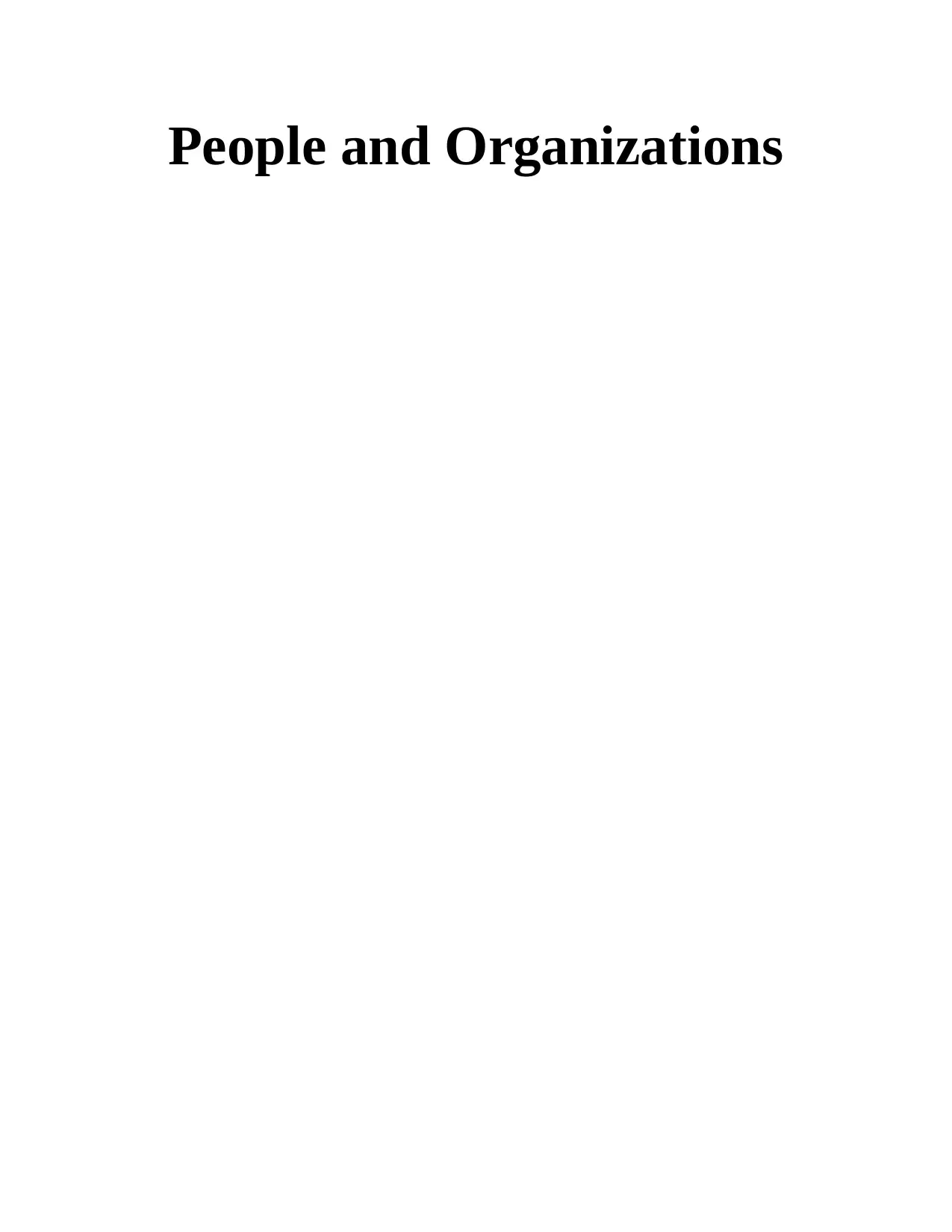
People and Organizations
Paraphrase This Document
Need a fresh take? Get an instant paraphrase of this document with our AI Paraphraser
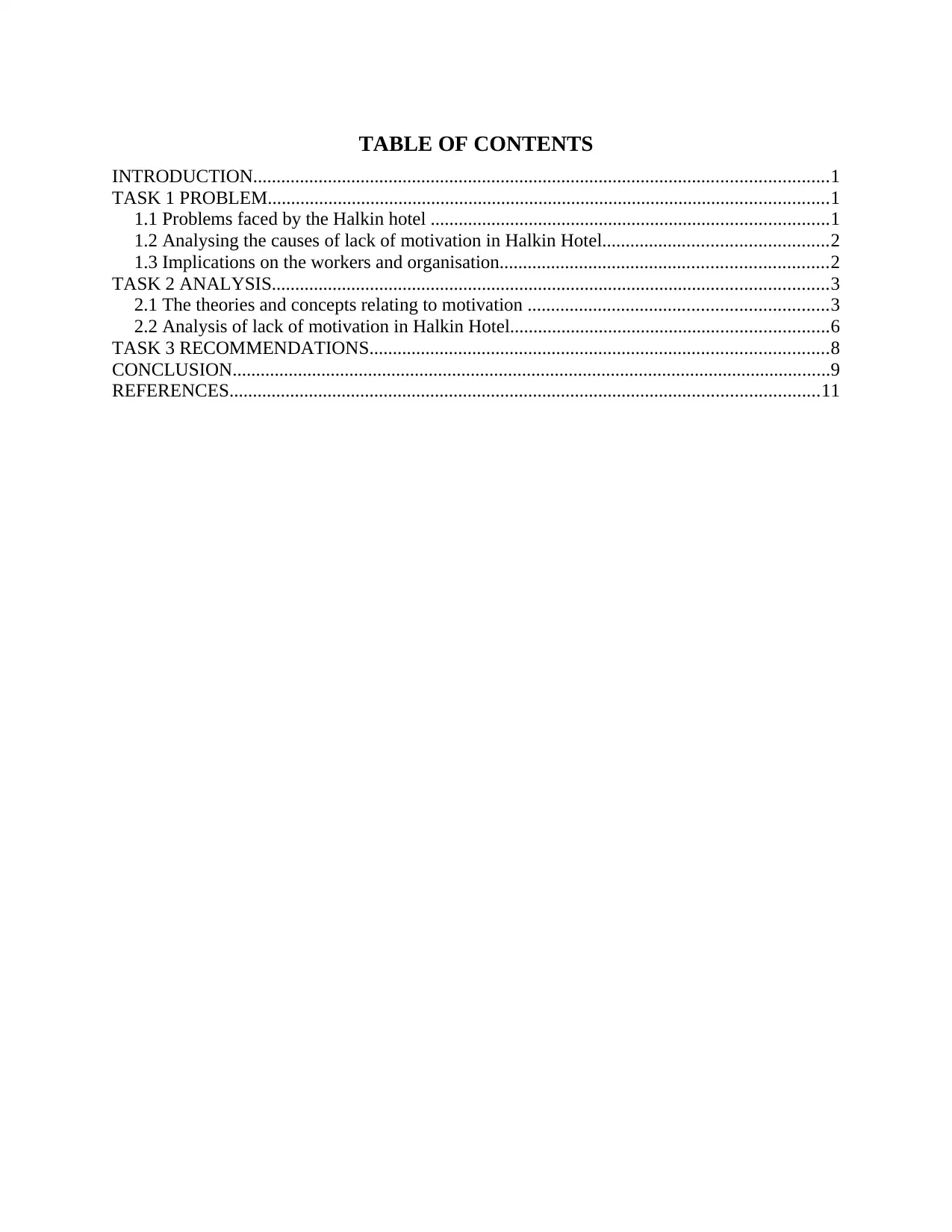
TABLE OF CONTENTS
INTRODUCTION...........................................................................................................................1
TASK 1 PROBLEM........................................................................................................................1
1.1 Problems faced by the Halkin hotel .....................................................................................1
1.2 Analysing the causes of lack of motivation in Halkin Hotel................................................2
1.3 Implications on the workers and organisation......................................................................2
TASK 2 ANALYSIS.......................................................................................................................3
2.1 The theories and concepts relating to motivation ................................................................3
2.2 Analysis of lack of motivation in Halkin Hotel....................................................................6
TASK 3 RECOMMENDATIONS..................................................................................................8
CONCLUSION................................................................................................................................9
REFERENCES..............................................................................................................................11
INTRODUCTION...........................................................................................................................1
TASK 1 PROBLEM........................................................................................................................1
1.1 Problems faced by the Halkin hotel .....................................................................................1
1.2 Analysing the causes of lack of motivation in Halkin Hotel................................................2
1.3 Implications on the workers and organisation......................................................................2
TASK 2 ANALYSIS.......................................................................................................................3
2.1 The theories and concepts relating to motivation ................................................................3
2.2 Analysis of lack of motivation in Halkin Hotel....................................................................6
TASK 3 RECOMMENDATIONS..................................................................................................8
CONCLUSION................................................................................................................................9
REFERENCES..............................................................................................................................11

ILLUSTRATION INDEX
Illustration 1: Maslow's Need hierarchy theory...............................................................................4
Illustration 2: Alferer's Theory........................................................................................................5
Illustration 3: Herzberg Two factor theory......................................................................................6
Illustration 4: Attribution Theory.....................................................................................................8
Illustration 1: Maslow's Need hierarchy theory...............................................................................4
Illustration 2: Alferer's Theory........................................................................................................5
Illustration 3: Herzberg Two factor theory......................................................................................6
Illustration 4: Attribution Theory.....................................................................................................8
⊘ This is a preview!⊘
Do you want full access?
Subscribe today to unlock all pages.

Trusted by 1+ million students worldwide
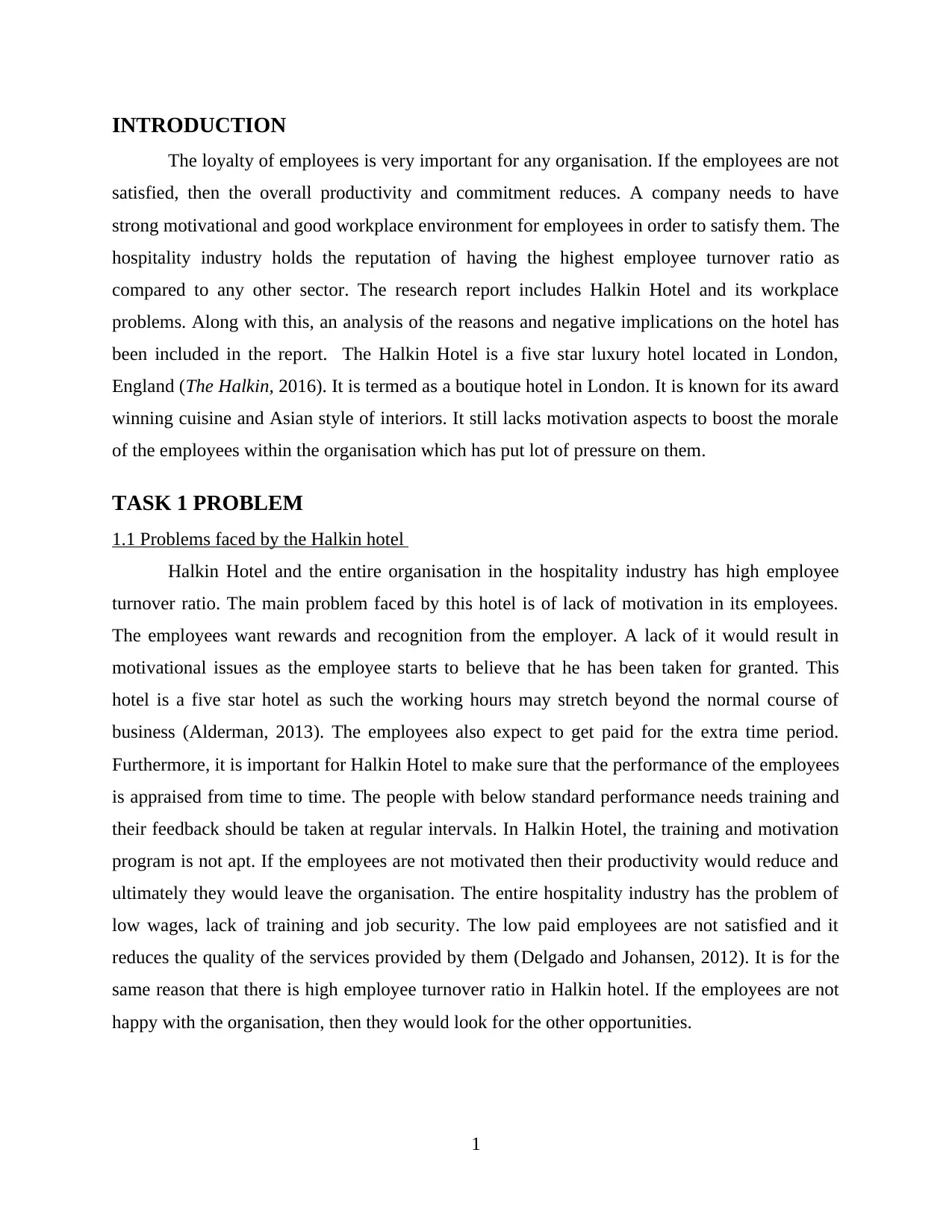
INTRODUCTION
The loyalty of employees is very important for any organisation. If the employees are not
satisfied, then the overall productivity and commitment reduces. A company needs to have
strong motivational and good workplace environment for employees in order to satisfy them. The
hospitality industry holds the reputation of having the highest employee turnover ratio as
compared to any other sector. The research report includes Halkin Hotel and its workplace
problems. Along with this, an analysis of the reasons and negative implications on the hotel has
been included in the report. The Halkin Hotel is a five star luxury hotel located in London,
England (The Halkin, 2016). It is termed as a boutique hotel in London. It is known for its award
winning cuisine and Asian style of interiors. It still lacks motivation aspects to boost the morale
of the employees within the organisation which has put lot of pressure on them.
TASK 1 PROBLEM
1.1 Problems faced by the Halkin hotel
Halkin Hotel and the entire organisation in the hospitality industry has high employee
turnover ratio. The main problem faced by this hotel is of lack of motivation in its employees.
The employees want rewards and recognition from the employer. A lack of it would result in
motivational issues as the employee starts to believe that he has been taken for granted. This
hotel is a five star hotel as such the working hours may stretch beyond the normal course of
business (Alderman, 2013). The employees also expect to get paid for the extra time period.
Furthermore, it is important for Halkin Hotel to make sure that the performance of the employees
is appraised from time to time. The people with below standard performance needs training and
their feedback should be taken at regular intervals. In Halkin Hotel, the training and motivation
program is not apt. If the employees are not motivated then their productivity would reduce and
ultimately they would leave the organisation. The entire hospitality industry has the problem of
low wages, lack of training and job security. The low paid employees are not satisfied and it
reduces the quality of the services provided by them (Delgado and Johansen, 2012). It is for the
same reason that there is high employee turnover ratio in Halkin hotel. If the employees are not
happy with the organisation, then they would look for the other opportunities.
1
The loyalty of employees is very important for any organisation. If the employees are not
satisfied, then the overall productivity and commitment reduces. A company needs to have
strong motivational and good workplace environment for employees in order to satisfy them. The
hospitality industry holds the reputation of having the highest employee turnover ratio as
compared to any other sector. The research report includes Halkin Hotel and its workplace
problems. Along with this, an analysis of the reasons and negative implications on the hotel has
been included in the report. The Halkin Hotel is a five star luxury hotel located in London,
England (The Halkin, 2016). It is termed as a boutique hotel in London. It is known for its award
winning cuisine and Asian style of interiors. It still lacks motivation aspects to boost the morale
of the employees within the organisation which has put lot of pressure on them.
TASK 1 PROBLEM
1.1 Problems faced by the Halkin hotel
Halkin Hotel and the entire organisation in the hospitality industry has high employee
turnover ratio. The main problem faced by this hotel is of lack of motivation in its employees.
The employees want rewards and recognition from the employer. A lack of it would result in
motivational issues as the employee starts to believe that he has been taken for granted. This
hotel is a five star hotel as such the working hours may stretch beyond the normal course of
business (Alderman, 2013). The employees also expect to get paid for the extra time period.
Furthermore, it is important for Halkin Hotel to make sure that the performance of the employees
is appraised from time to time. The people with below standard performance needs training and
their feedback should be taken at regular intervals. In Halkin Hotel, the training and motivation
program is not apt. If the employees are not motivated then their productivity would reduce and
ultimately they would leave the organisation. The entire hospitality industry has the problem of
low wages, lack of training and job security. The low paid employees are not satisfied and it
reduces the quality of the services provided by them (Delgado and Johansen, 2012). It is for the
same reason that there is high employee turnover ratio in Halkin hotel. If the employees are not
happy with the organisation, then they would look for the other opportunities.
1
Paraphrase This Document
Need a fresh take? Get an instant paraphrase of this document with our AI Paraphraser
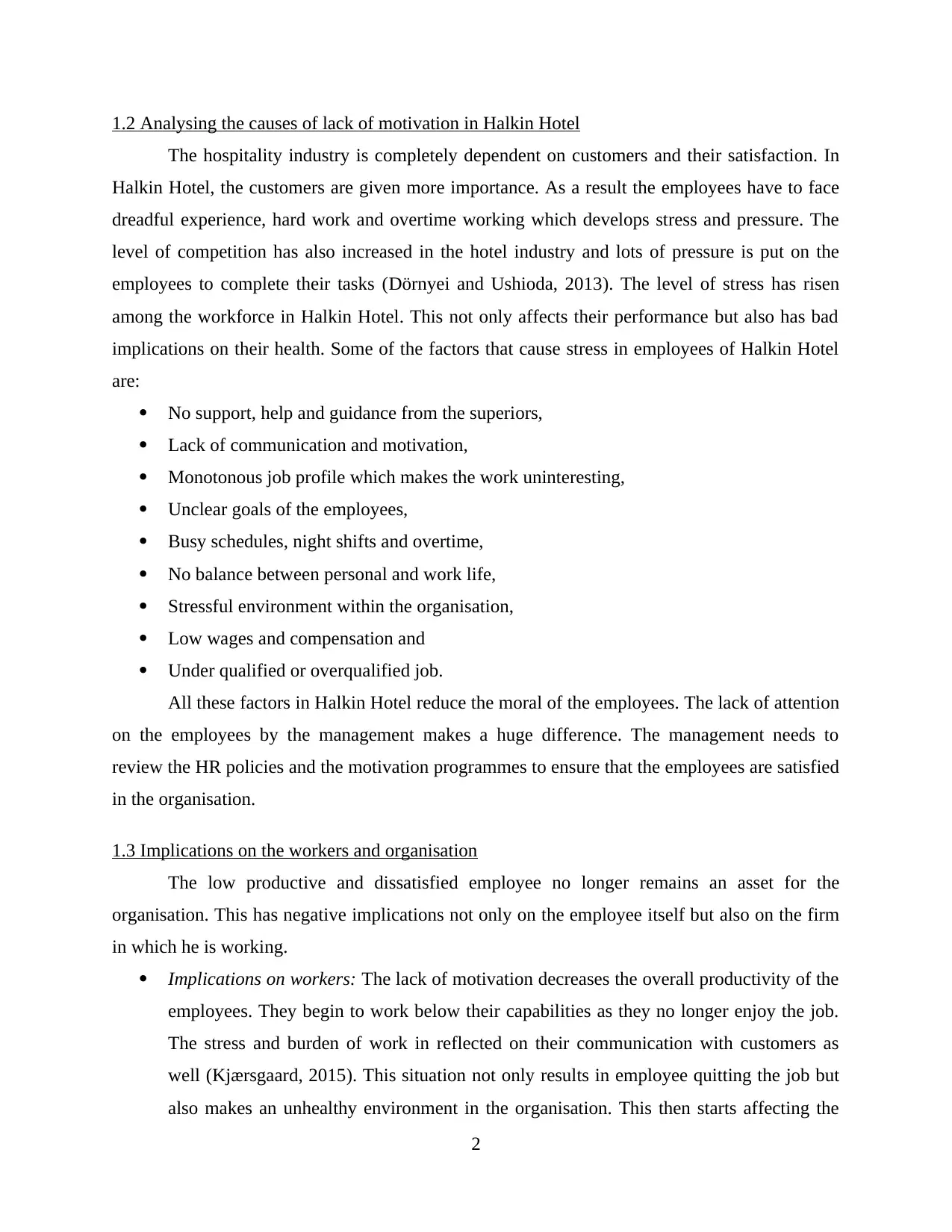
1.2 Analysing the causes of lack of motivation in Halkin Hotel
The hospitality industry is completely dependent on customers and their satisfaction. In
Halkin Hotel, the customers are given more importance. As a result the employees have to face
dreadful experience, hard work and overtime working which develops stress and pressure. The
level of competition has also increased in the hotel industry and lots of pressure is put on the
employees to complete their tasks (Dörnyei and Ushioda, 2013). The level of stress has risen
among the workforce in Halkin Hotel. This not only affects their performance but also has bad
implications on their health. Some of the factors that cause stress in employees of Halkin Hotel
are:
No support, help and guidance from the superiors,
Lack of communication and motivation,
Monotonous job profile which makes the work uninteresting,
Unclear goals of the employees,
Busy schedules, night shifts and overtime,
No balance between personal and work life,
Stressful environment within the organisation,
Low wages and compensation and
Under qualified or overqualified job.
All these factors in Halkin Hotel reduce the moral of the employees. The lack of attention
on the employees by the management makes a huge difference. The management needs to
review the HR policies and the motivation programmes to ensure that the employees are satisfied
in the organisation.
1.3 Implications on the workers and organisation
The low productive and dissatisfied employee no longer remains an asset for the
organisation. This has negative implications not only on the employee itself but also on the firm
in which he is working.
Implications on workers: The lack of motivation decreases the overall productivity of the
employees. They begin to work below their capabilities as they no longer enjoy the job.
The stress and burden of work in reflected on their communication with customers as
well (Kjærsgaard, 2015). This situation not only results in employee quitting the job but
also makes an unhealthy environment in the organisation. This then starts affecting the
2
The hospitality industry is completely dependent on customers and their satisfaction. In
Halkin Hotel, the customers are given more importance. As a result the employees have to face
dreadful experience, hard work and overtime working which develops stress and pressure. The
level of competition has also increased in the hotel industry and lots of pressure is put on the
employees to complete their tasks (Dörnyei and Ushioda, 2013). The level of stress has risen
among the workforce in Halkin Hotel. This not only affects their performance but also has bad
implications on their health. Some of the factors that cause stress in employees of Halkin Hotel
are:
No support, help and guidance from the superiors,
Lack of communication and motivation,
Monotonous job profile which makes the work uninteresting,
Unclear goals of the employees,
Busy schedules, night shifts and overtime,
No balance between personal and work life,
Stressful environment within the organisation,
Low wages and compensation and
Under qualified or overqualified job.
All these factors in Halkin Hotel reduce the moral of the employees. The lack of attention
on the employees by the management makes a huge difference. The management needs to
review the HR policies and the motivation programmes to ensure that the employees are satisfied
in the organisation.
1.3 Implications on the workers and organisation
The low productive and dissatisfied employee no longer remains an asset for the
organisation. This has negative implications not only on the employee itself but also on the firm
in which he is working.
Implications on workers: The lack of motivation decreases the overall productivity of the
employees. They begin to work below their capabilities as they no longer enjoy the job.
The stress and burden of work in reflected on their communication with customers as
well (Kjærsgaard, 2015). This situation not only results in employee quitting the job but
also makes an unhealthy environment in the organisation. This then starts affecting the
2
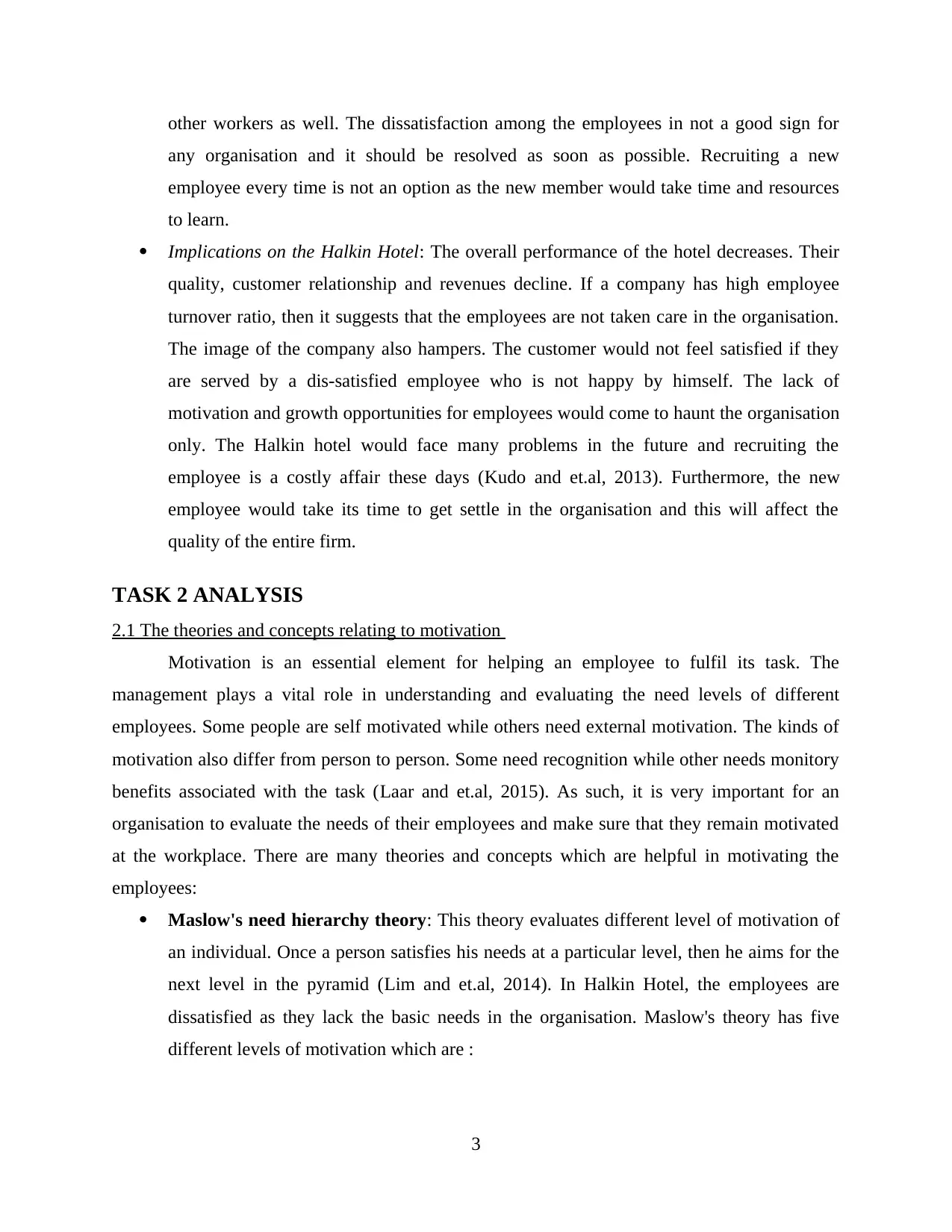
other workers as well. The dissatisfaction among the employees in not a good sign for
any organisation and it should be resolved as soon as possible. Recruiting a new
employee every time is not an option as the new member would take time and resources
to learn.
Implications on the Halkin Hotel: The overall performance of the hotel decreases. Their
quality, customer relationship and revenues decline. If a company has high employee
turnover ratio, then it suggests that the employees are not taken care in the organisation.
The image of the company also hampers. The customer would not feel satisfied if they
are served by a dis-satisfied employee who is not happy by himself. The lack of
motivation and growth opportunities for employees would come to haunt the organisation
only. The Halkin hotel would face many problems in the future and recruiting the
employee is a costly affair these days (Kudo and et.al, 2013). Furthermore, the new
employee would take its time to get settle in the organisation and this will affect the
quality of the entire firm.
TASK 2 ANALYSIS
2.1 The theories and concepts relating to motivation
Motivation is an essential element for helping an employee to fulfil its task. The
management plays a vital role in understanding and evaluating the need levels of different
employees. Some people are self motivated while others need external motivation. The kinds of
motivation also differ from person to person. Some need recognition while other needs monitory
benefits associated with the task (Laar and et.al, 2015). As such, it is very important for an
organisation to evaluate the needs of their employees and make sure that they remain motivated
at the workplace. There are many theories and concepts which are helpful in motivating the
employees:
Maslow's need hierarchy theory: This theory evaluates different level of motivation of
an individual. Once a person satisfies his needs at a particular level, then he aims for the
next level in the pyramid (Lim and et.al, 2014). In Halkin Hotel, the employees are
dissatisfied as they lack the basic needs in the organisation. Maslow's theory has five
different levels of motivation which are :
3
any organisation and it should be resolved as soon as possible. Recruiting a new
employee every time is not an option as the new member would take time and resources
to learn.
Implications on the Halkin Hotel: The overall performance of the hotel decreases. Their
quality, customer relationship and revenues decline. If a company has high employee
turnover ratio, then it suggests that the employees are not taken care in the organisation.
The image of the company also hampers. The customer would not feel satisfied if they
are served by a dis-satisfied employee who is not happy by himself. The lack of
motivation and growth opportunities for employees would come to haunt the organisation
only. The Halkin hotel would face many problems in the future and recruiting the
employee is a costly affair these days (Kudo and et.al, 2013). Furthermore, the new
employee would take its time to get settle in the organisation and this will affect the
quality of the entire firm.
TASK 2 ANALYSIS
2.1 The theories and concepts relating to motivation
Motivation is an essential element for helping an employee to fulfil its task. The
management plays a vital role in understanding and evaluating the need levels of different
employees. Some people are self motivated while others need external motivation. The kinds of
motivation also differ from person to person. Some need recognition while other needs monitory
benefits associated with the task (Laar and et.al, 2015). As such, it is very important for an
organisation to evaluate the needs of their employees and make sure that they remain motivated
at the workplace. There are many theories and concepts which are helpful in motivating the
employees:
Maslow's need hierarchy theory: This theory evaluates different level of motivation of
an individual. Once a person satisfies his needs at a particular level, then he aims for the
next level in the pyramid (Lim and et.al, 2014). In Halkin Hotel, the employees are
dissatisfied as they lack the basic needs in the organisation. Maslow's theory has five
different levels of motivation which are :
3
⊘ This is a preview!⊘
Do you want full access?
Subscribe today to unlock all pages.

Trusted by 1+ million students worldwide
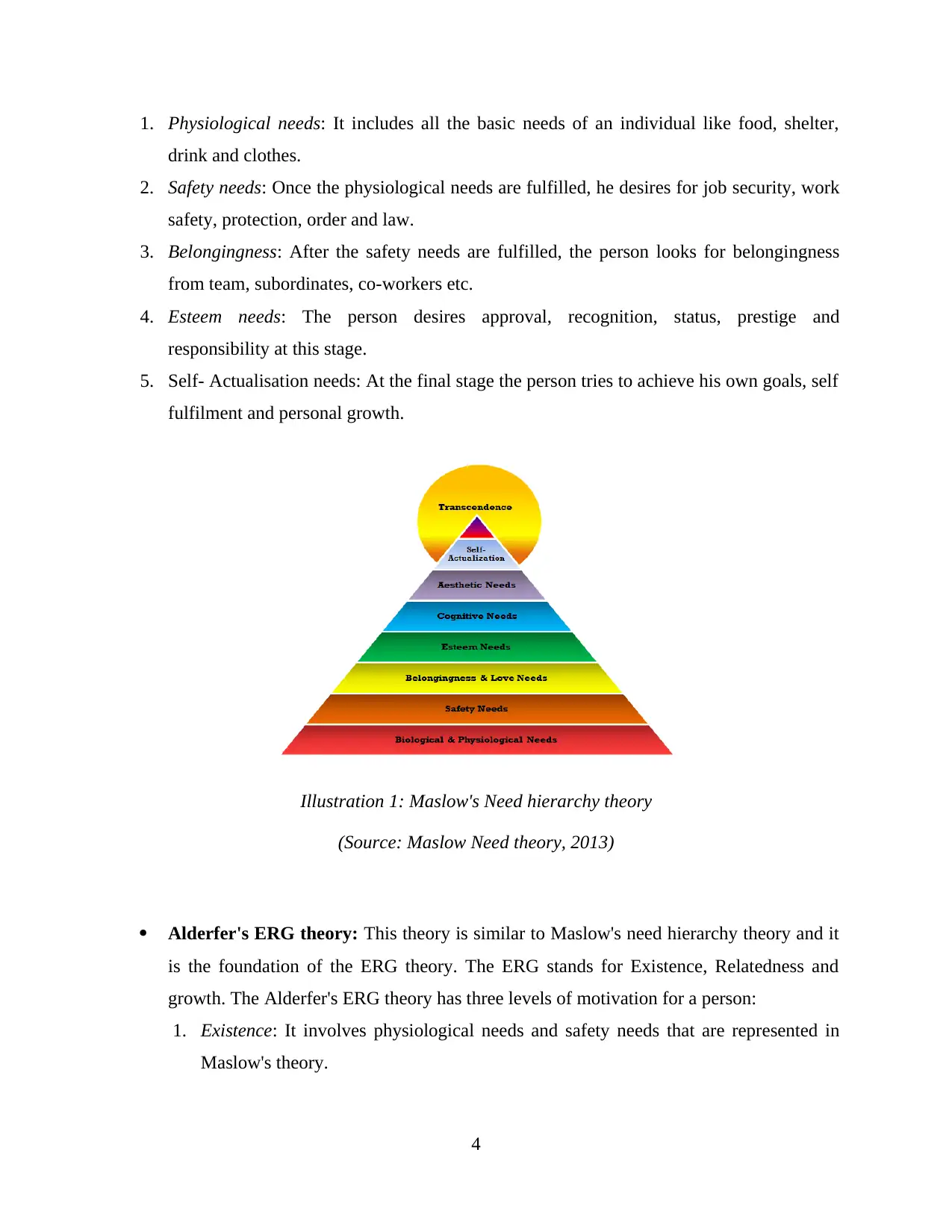
1. Physiological needs: It includes all the basic needs of an individual like food, shelter,
drink and clothes.
2. Safety needs: Once the physiological needs are fulfilled, he desires for job security, work
safety, protection, order and law.
3. Belongingness: After the safety needs are fulfilled, the person looks for belongingness
from team, subordinates, co-workers etc.
4. Esteem needs: The person desires approval, recognition, status, prestige and
responsibility at this stage.
5. Self- Actualisation needs: At the final stage the person tries to achieve his own goals, self
fulfilment and personal growth.
Alderfer's ERG theory: This theory is similar to Maslow's need hierarchy theory and it
is the foundation of the ERG theory. The ERG stands for Existence, Relatedness and
growth. The Alderfer's ERG theory has three levels of motivation for a person:
1. Existence: It involves physiological needs and safety needs that are represented in
Maslow's theory.
4
Illustration 1: Maslow's Need hierarchy theory
(Source: Maslow Need theory, 2013)
drink and clothes.
2. Safety needs: Once the physiological needs are fulfilled, he desires for job security, work
safety, protection, order and law.
3. Belongingness: After the safety needs are fulfilled, the person looks for belongingness
from team, subordinates, co-workers etc.
4. Esteem needs: The person desires approval, recognition, status, prestige and
responsibility at this stage.
5. Self- Actualisation needs: At the final stage the person tries to achieve his own goals, self
fulfilment and personal growth.
Alderfer's ERG theory: This theory is similar to Maslow's need hierarchy theory and it
is the foundation of the ERG theory. The ERG stands for Existence, Relatedness and
growth. The Alderfer's ERG theory has three levels of motivation for a person:
1. Existence: It involves physiological needs and safety needs that are represented in
Maslow's theory.
4
Illustration 1: Maslow's Need hierarchy theory
(Source: Maslow Need theory, 2013)
Paraphrase This Document
Need a fresh take? Get an instant paraphrase of this document with our AI Paraphraser
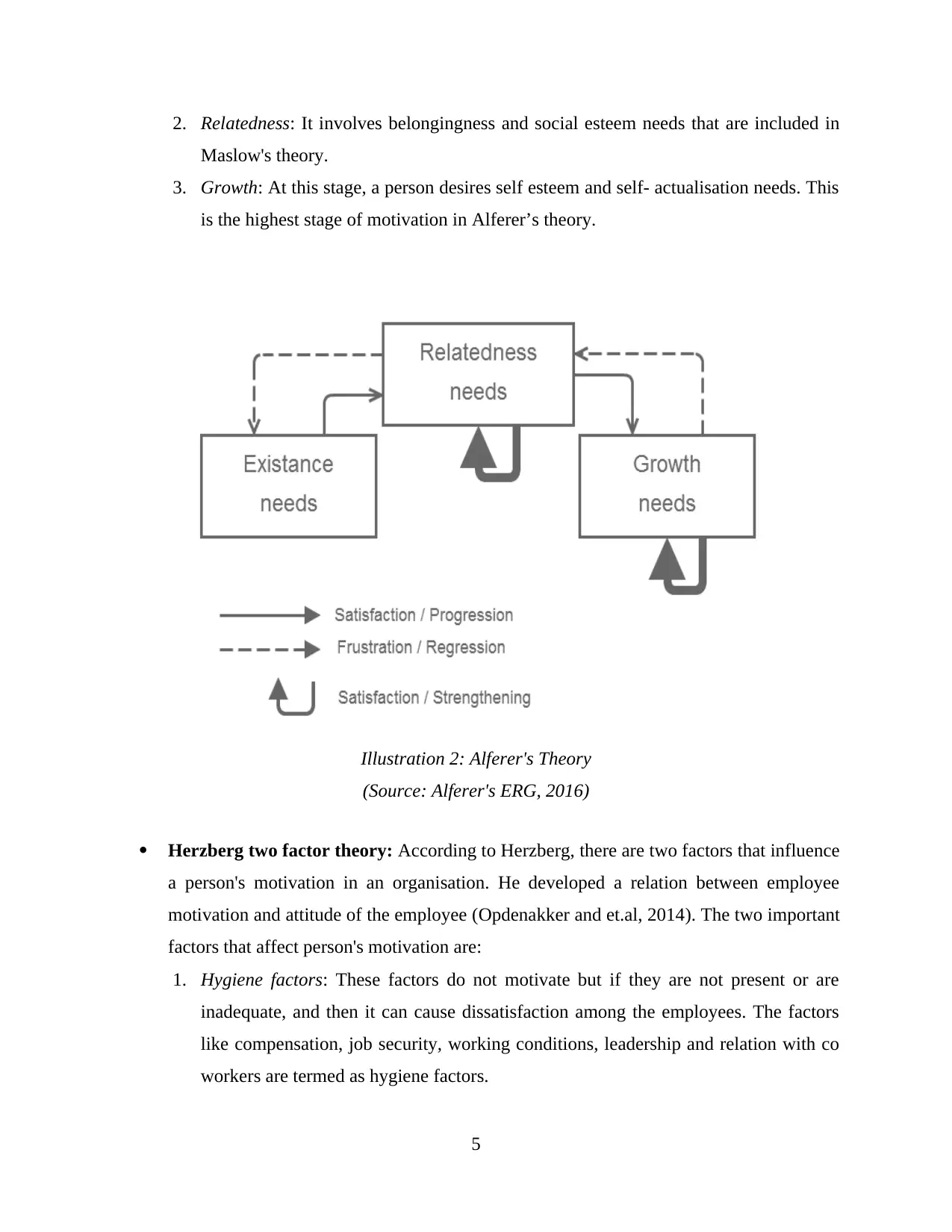
2. Relatedness: It involves belongingness and social esteem needs that are included in
Maslow's theory.
3. Growth: At this stage, a person desires self esteem and self- actualisation needs. This
is the highest stage of motivation in Alferer’s theory.
Herzberg two factor theory: According to Herzberg, there are two factors that influence
a person's motivation in an organisation. He developed a relation between employee
motivation and attitude of the employee (Opdenakker and et.al, 2014). The two important
factors that affect person's motivation are:
1. Hygiene factors: These factors do not motivate but if they are not present or are
inadequate, and then it can cause dissatisfaction among the employees. The factors
like compensation, job security, working conditions, leadership and relation with co
workers are termed as hygiene factors.
5
Illustration 2: Alferer's Theory
(Source: Alferer's ERG, 2016)
Maslow's theory.
3. Growth: At this stage, a person desires self esteem and self- actualisation needs. This
is the highest stage of motivation in Alferer’s theory.
Herzberg two factor theory: According to Herzberg, there are two factors that influence
a person's motivation in an organisation. He developed a relation between employee
motivation and attitude of the employee (Opdenakker and et.al, 2014). The two important
factors that affect person's motivation are:
1. Hygiene factors: These factors do not motivate but if they are not present or are
inadequate, and then it can cause dissatisfaction among the employees. The factors
like compensation, job security, working conditions, leadership and relation with co
workers are termed as hygiene factors.
5
Illustration 2: Alferer's Theory
(Source: Alferer's ERG, 2016)
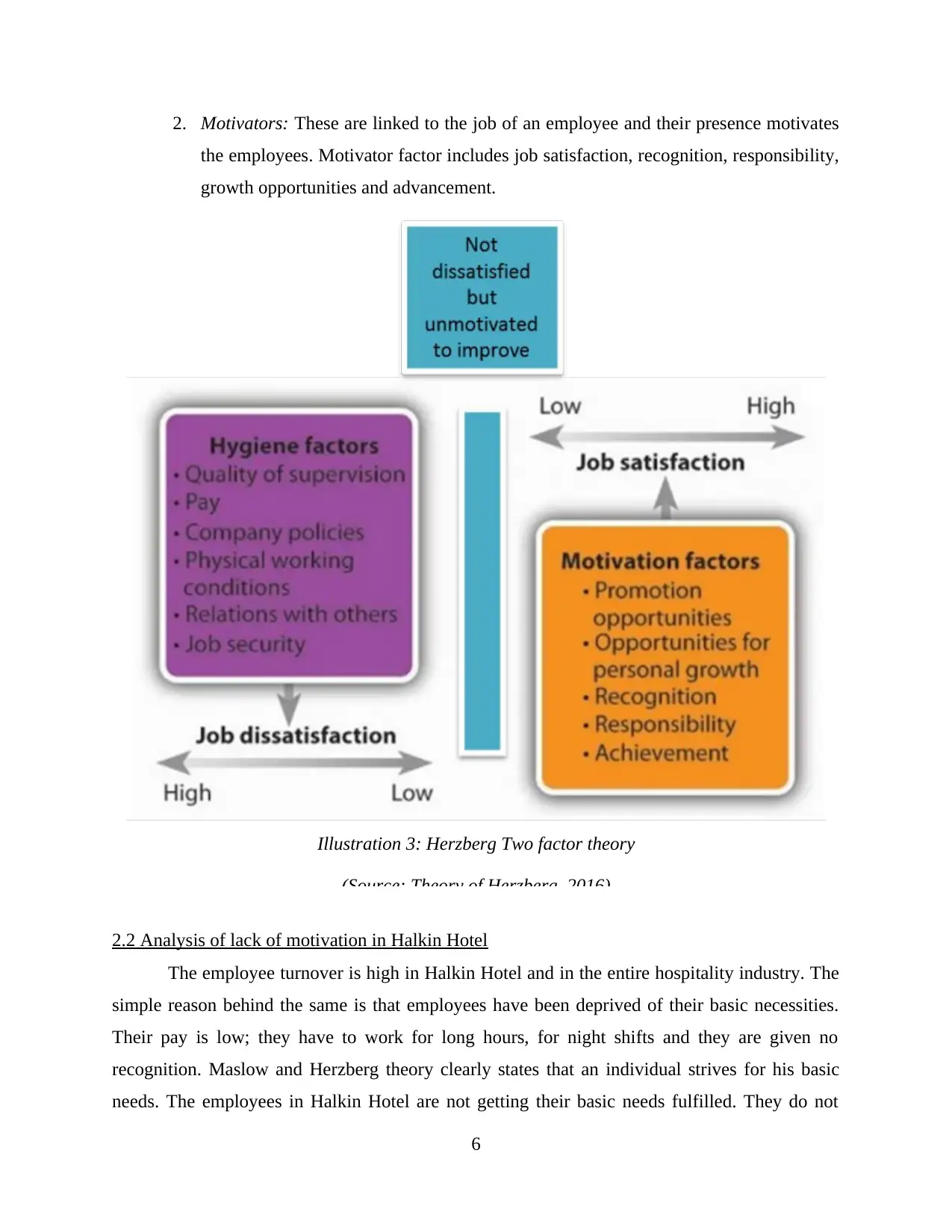
2. Motivators: These are linked to the job of an employee and their presence motivates
the employees. Motivator factor includes job satisfaction, recognition, responsibility,
growth opportunities and advancement.
2.2 Analysis of lack of motivation in Halkin Hotel
The employee turnover is high in Halkin Hotel and in the entire hospitality industry. The
simple reason behind the same is that employees have been deprived of their basic necessities.
Their pay is low; they have to work for long hours, for night shifts and they are given no
recognition. Maslow and Herzberg theory clearly states that an individual strives for his basic
needs. The employees in Halkin Hotel are not getting their basic needs fulfilled. They do not
6
Illustration 3: Herzberg Two factor theory
(Source: Theory of Herzberg, 2016)
the employees. Motivator factor includes job satisfaction, recognition, responsibility,
growth opportunities and advancement.
2.2 Analysis of lack of motivation in Halkin Hotel
The employee turnover is high in Halkin Hotel and in the entire hospitality industry. The
simple reason behind the same is that employees have been deprived of their basic necessities.
Their pay is low; they have to work for long hours, for night shifts and they are given no
recognition. Maslow and Herzberg theory clearly states that an individual strives for his basic
needs. The employees in Halkin Hotel are not getting their basic needs fulfilled. They do not
6
Illustration 3: Herzberg Two factor theory
(Source: Theory of Herzberg, 2016)
⊘ This is a preview!⊘
Do you want full access?
Subscribe today to unlock all pages.

Trusted by 1+ million students worldwide
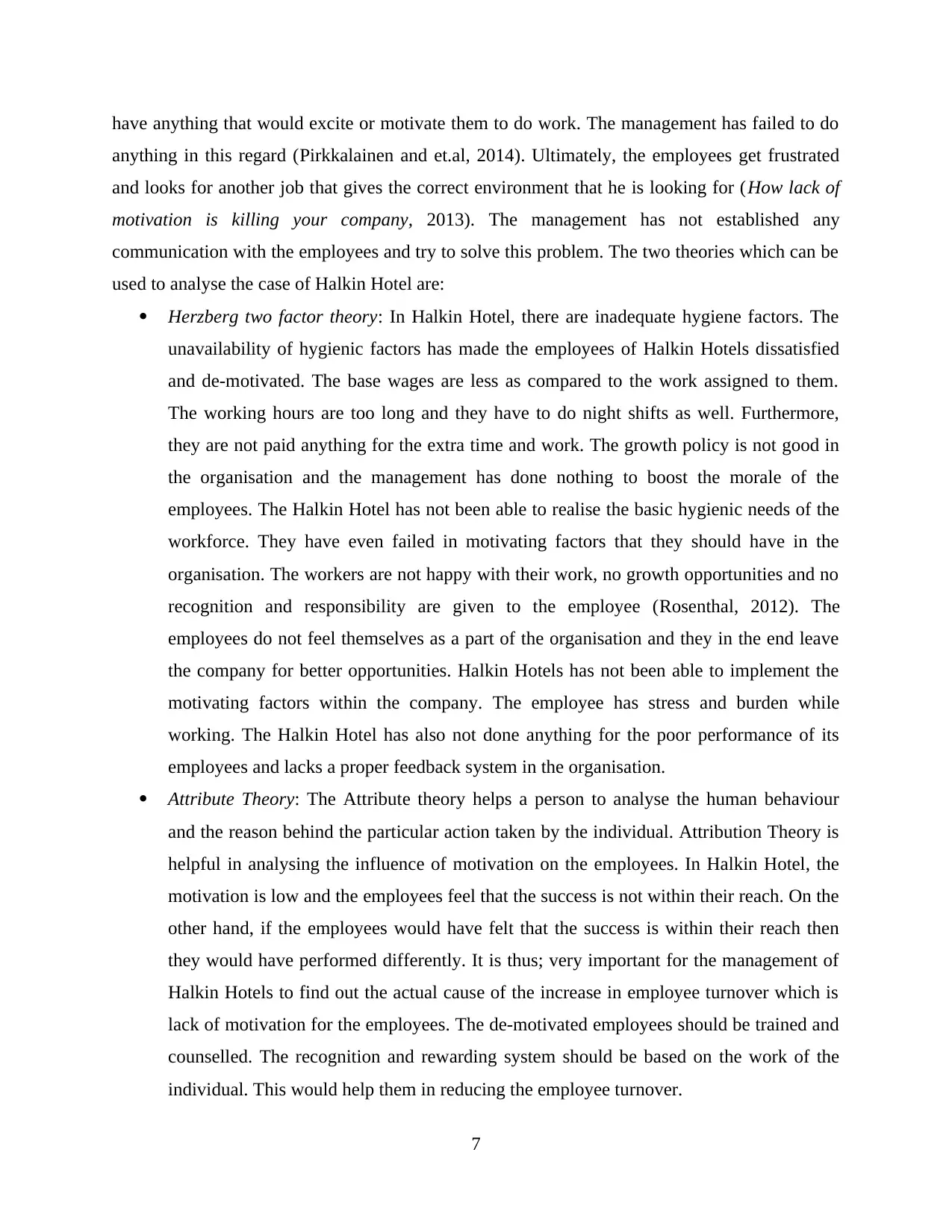
have anything that would excite or motivate them to do work. The management has failed to do
anything in this regard (Pirkkalainen and et.al, 2014). Ultimately, the employees get frustrated
and looks for another job that gives the correct environment that he is looking for (How lack of
motivation is killing your company, 2013). The management has not established any
communication with the employees and try to solve this problem. The two theories which can be
used to analyse the case of Halkin Hotel are:
Herzberg two factor theory: In Halkin Hotel, there are inadequate hygiene factors. The
unavailability of hygienic factors has made the employees of Halkin Hotels dissatisfied
and de-motivated. The base wages are less as compared to the work assigned to them.
The working hours are too long and they have to do night shifts as well. Furthermore,
they are not paid anything for the extra time and work. The growth policy is not good in
the organisation and the management has done nothing to boost the morale of the
employees. The Halkin Hotel has not been able to realise the basic hygienic needs of the
workforce. They have even failed in motivating factors that they should have in the
organisation. The workers are not happy with their work, no growth opportunities and no
recognition and responsibility are given to the employee (Rosenthal, 2012). The
employees do not feel themselves as a part of the organisation and they in the end leave
the company for better opportunities. Halkin Hotels has not been able to implement the
motivating factors within the company. The employee has stress and burden while
working. The Halkin Hotel has also not done anything for the poor performance of its
employees and lacks a proper feedback system in the organisation.
Attribute Theory: The Attribute theory helps a person to analyse the human behaviour
and the reason behind the particular action taken by the individual. Attribution Theory is
helpful in analysing the influence of motivation on the employees. In Halkin Hotel, the
motivation is low and the employees feel that the success is not within their reach. On the
other hand, if the employees would have felt that the success is within their reach then
they would have performed differently. It is thus; very important for the management of
Halkin Hotels to find out the actual cause of the increase in employee turnover which is
lack of motivation for the employees. The de-motivated employees should be trained and
counselled. The recognition and rewarding system should be based on the work of the
individual. This would help them in reducing the employee turnover.
7
anything in this regard (Pirkkalainen and et.al, 2014). Ultimately, the employees get frustrated
and looks for another job that gives the correct environment that he is looking for (How lack of
motivation is killing your company, 2013). The management has not established any
communication with the employees and try to solve this problem. The two theories which can be
used to analyse the case of Halkin Hotel are:
Herzberg two factor theory: In Halkin Hotel, there are inadequate hygiene factors. The
unavailability of hygienic factors has made the employees of Halkin Hotels dissatisfied
and de-motivated. The base wages are less as compared to the work assigned to them.
The working hours are too long and they have to do night shifts as well. Furthermore,
they are not paid anything for the extra time and work. The growth policy is not good in
the organisation and the management has done nothing to boost the morale of the
employees. The Halkin Hotel has not been able to realise the basic hygienic needs of the
workforce. They have even failed in motivating factors that they should have in the
organisation. The workers are not happy with their work, no growth opportunities and no
recognition and responsibility are given to the employee (Rosenthal, 2012). The
employees do not feel themselves as a part of the organisation and they in the end leave
the company for better opportunities. Halkin Hotels has not been able to implement the
motivating factors within the company. The employee has stress and burden while
working. The Halkin Hotel has also not done anything for the poor performance of its
employees and lacks a proper feedback system in the organisation.
Attribute Theory: The Attribute theory helps a person to analyse the human behaviour
and the reason behind the particular action taken by the individual. Attribution Theory is
helpful in analysing the influence of motivation on the employees. In Halkin Hotel, the
motivation is low and the employees feel that the success is not within their reach. On the
other hand, if the employees would have felt that the success is within their reach then
they would have performed differently. It is thus; very important for the management of
Halkin Hotels to find out the actual cause of the increase in employee turnover which is
lack of motivation for the employees. The de-motivated employees should be trained and
counselled. The recognition and rewarding system should be based on the work of the
individual. This would help them in reducing the employee turnover.
7
Paraphrase This Document
Need a fresh take? Get an instant paraphrase of this document with our AI Paraphraser
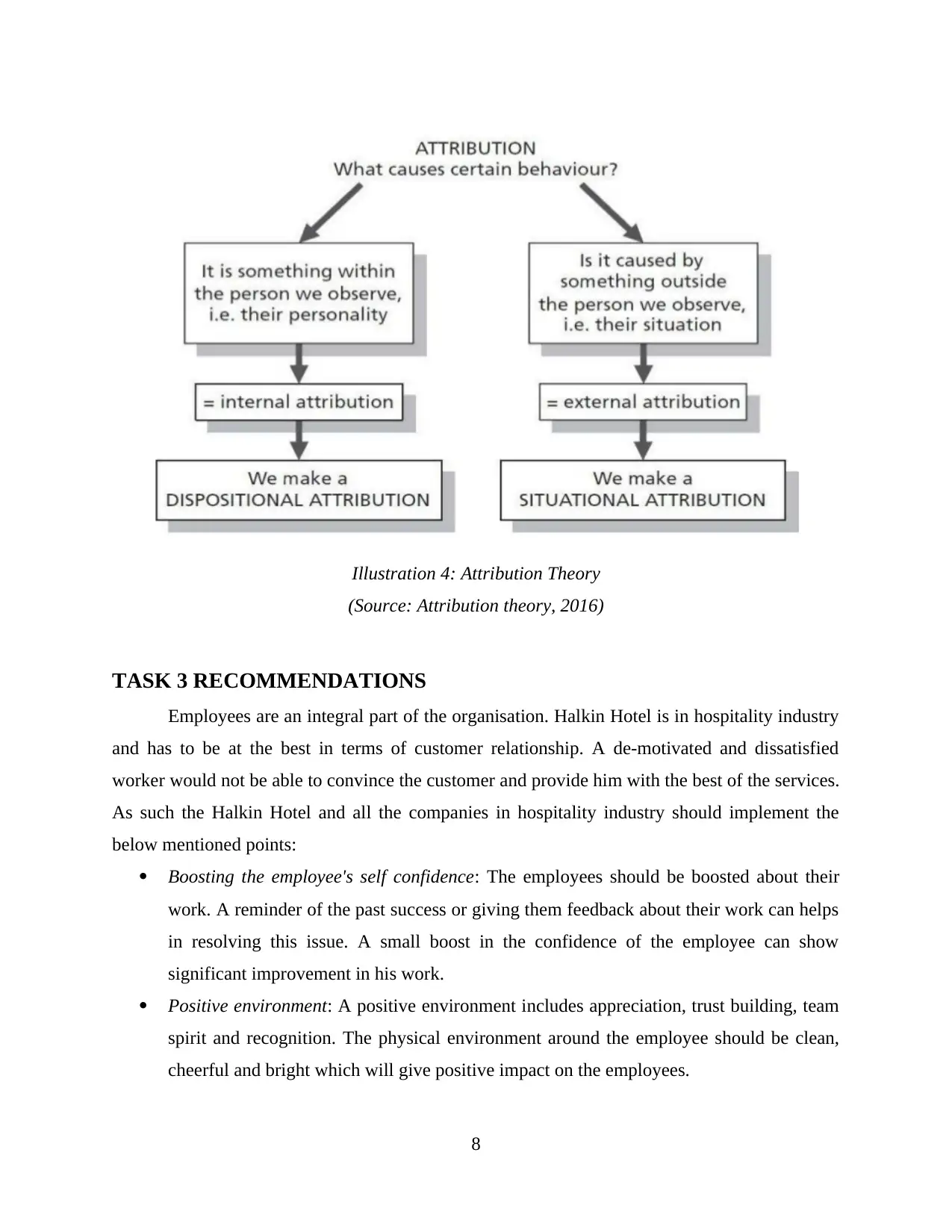
TASK 3 RECOMMENDATIONS
Employees are an integral part of the organisation. Halkin Hotel is in hospitality industry
and has to be at the best in terms of customer relationship. A de-motivated and dissatisfied
worker would not be able to convince the customer and provide him with the best of the services.
As such the Halkin Hotel and all the companies in hospitality industry should implement the
below mentioned points:
Boosting the employee's self confidence: The employees should be boosted about their
work. A reminder of the past success or giving them feedback about their work can helps
in resolving this issue. A small boost in the confidence of the employee can show
significant improvement in his work.
Positive environment: A positive environment includes appreciation, trust building, team
spirit and recognition. The physical environment around the employee should be clean,
cheerful and bright which will give positive impact on the employees.
8
Illustration 4: Attribution Theory
(Source: Attribution theory, 2016)
Employees are an integral part of the organisation. Halkin Hotel is in hospitality industry
and has to be at the best in terms of customer relationship. A de-motivated and dissatisfied
worker would not be able to convince the customer and provide him with the best of the services.
As such the Halkin Hotel and all the companies in hospitality industry should implement the
below mentioned points:
Boosting the employee's self confidence: The employees should be boosted about their
work. A reminder of the past success or giving them feedback about their work can helps
in resolving this issue. A small boost in the confidence of the employee can show
significant improvement in his work.
Positive environment: A positive environment includes appreciation, trust building, team
spirit and recognition. The physical environment around the employee should be clean,
cheerful and bright which will give positive impact on the employees.
8
Illustration 4: Attribution Theory
(Source: Attribution theory, 2016)
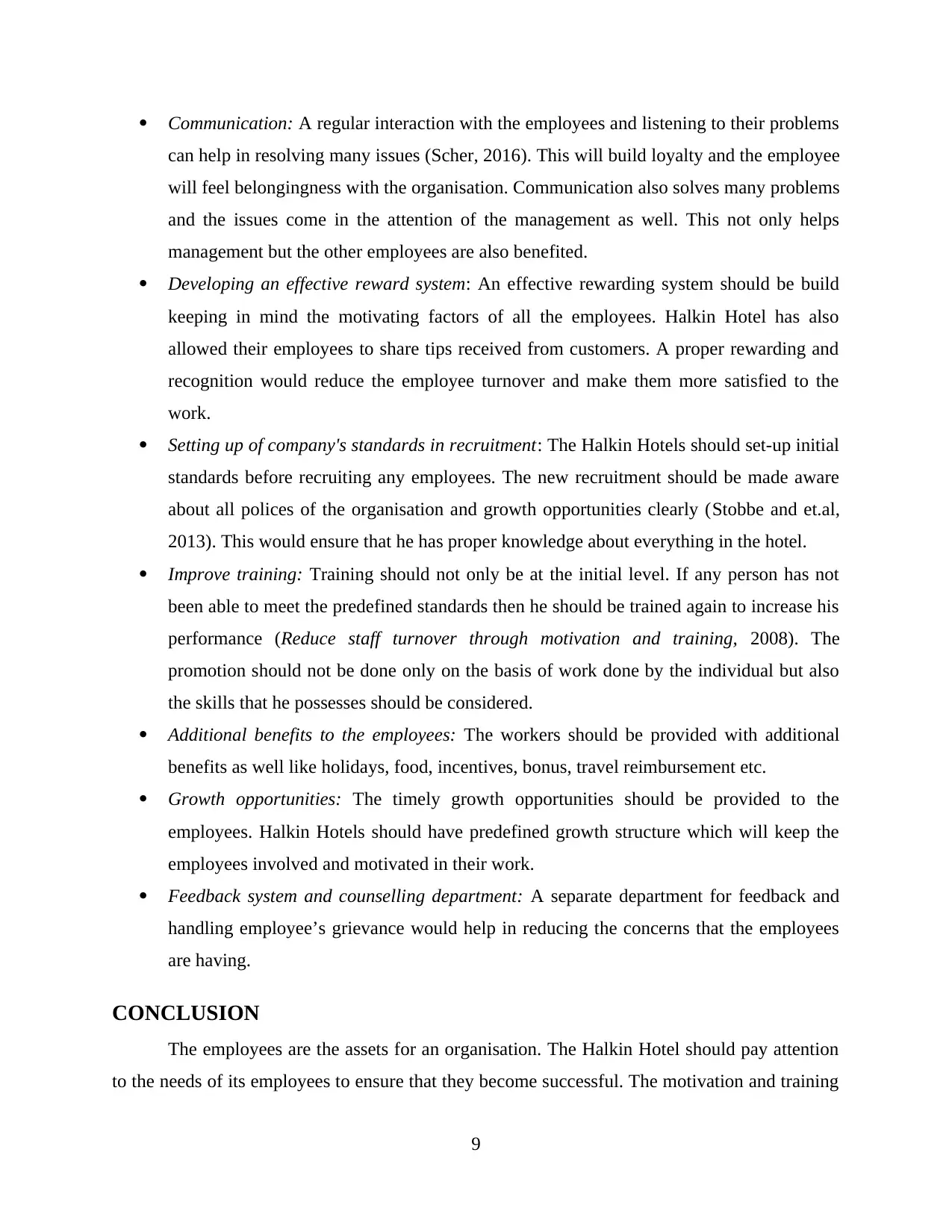
Communication: A regular interaction with the employees and listening to their problems
can help in resolving many issues (Scher, 2016). This will build loyalty and the employee
will feel belongingness with the organisation. Communication also solves many problems
and the issues come in the attention of the management as well. This not only helps
management but the other employees are also benefited.
Developing an effective reward system: An effective rewarding system should be build
keeping in mind the motivating factors of all the employees. Halkin Hotel has also
allowed their employees to share tips received from customers. A proper rewarding and
recognition would reduce the employee turnover and make them more satisfied to the
work.
Setting up of company's standards in recruitment: The Halkin Hotels should set-up initial
standards before recruiting any employees. The new recruitment should be made aware
about all polices of the organisation and growth opportunities clearly (Stobbe and et.al,
2013). This would ensure that he has proper knowledge about everything in the hotel.
Improve training: Training should not only be at the initial level. If any person has not
been able to meet the predefined standards then he should be trained again to increase his
performance (Reduce staff turnover through motivation and training, 2008). The
promotion should not be done only on the basis of work done by the individual but also
the skills that he possesses should be considered.
Additional benefits to the employees: The workers should be provided with additional
benefits as well like holidays, food, incentives, bonus, travel reimbursement etc.
Growth opportunities: The timely growth opportunities should be provided to the
employees. Halkin Hotels should have predefined growth structure which will keep the
employees involved and motivated in their work.
Feedback system and counselling department: A separate department for feedback and
handling employee’s grievance would help in reducing the concerns that the employees
are having.
CONCLUSION
The employees are the assets for an organisation. The Halkin Hotel should pay attention
to the needs of its employees to ensure that they become successful. The motivation and training
9
can help in resolving many issues (Scher, 2016). This will build loyalty and the employee
will feel belongingness with the organisation. Communication also solves many problems
and the issues come in the attention of the management as well. This not only helps
management but the other employees are also benefited.
Developing an effective reward system: An effective rewarding system should be build
keeping in mind the motivating factors of all the employees. Halkin Hotel has also
allowed their employees to share tips received from customers. A proper rewarding and
recognition would reduce the employee turnover and make them more satisfied to the
work.
Setting up of company's standards in recruitment: The Halkin Hotels should set-up initial
standards before recruiting any employees. The new recruitment should be made aware
about all polices of the organisation and growth opportunities clearly (Stobbe and et.al,
2013). This would ensure that he has proper knowledge about everything in the hotel.
Improve training: Training should not only be at the initial level. If any person has not
been able to meet the predefined standards then he should be trained again to increase his
performance (Reduce staff turnover through motivation and training, 2008). The
promotion should not be done only on the basis of work done by the individual but also
the skills that he possesses should be considered.
Additional benefits to the employees: The workers should be provided with additional
benefits as well like holidays, food, incentives, bonus, travel reimbursement etc.
Growth opportunities: The timely growth opportunities should be provided to the
employees. Halkin Hotels should have predefined growth structure which will keep the
employees involved and motivated in their work.
Feedback system and counselling department: A separate department for feedback and
handling employee’s grievance would help in reducing the concerns that the employees
are having.
CONCLUSION
The employees are the assets for an organisation. The Halkin Hotel should pay attention
to the needs of its employees to ensure that they become successful. The motivation and training
9
⊘ This is a preview!⊘
Do you want full access?
Subscribe today to unlock all pages.

Trusted by 1+ million students worldwide
1 out of 15
Related Documents
Your All-in-One AI-Powered Toolkit for Academic Success.
+13062052269
info@desklib.com
Available 24*7 on WhatsApp / Email
![[object Object]](/_next/static/media/star-bottom.7253800d.svg)
Unlock your academic potential
Copyright © 2020–2025 A2Z Services. All Rights Reserved. Developed and managed by ZUCOL.





